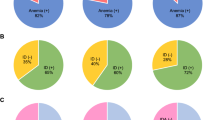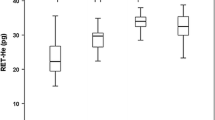Abstract
Background
Anemia is a major complication for patients on chronic dialysis. Erythropoietin is effective if iron is available, however unnecessary iron supplementation results in iron overload. Reticulocyte hemoglobin equivalent (Ret-He) may be useful for assessing iron status.
Methods
A national retrospective cohort study including all children on chronic dialysis in New Zealand between 2007 and 2013, pairing Ret-He with demographic information, anemia indices, and markers of iron status.
Results
In 606 observations, we found a modest relationship between Ret-He and transferrin saturation (TSAT) (r = 0.34, p < 0.001) and a poor correlation between Ret-He and ferritin (r = 0.09, p = 0.04). There was a negative correlation between ferritin and hemoglobin (r = −0.14, p = 0.002), a weak positive correlation between TSAT and hemoglobin (r = 0.12, p = 0.007), and a modest positive correlation between Ret-He and hemoglobin (r = 0.22, p < 0.001). The diagnostic performance of Ret-He to detect absolute iron deficiency (cut-off value 28.9 pg, sensitivity 90 %, specificity 75 %, AUC 0.87) was good.
Conclusions
Ret-He is a more relevant marker of iron status than ferritin and TSAT. This supports prospectively testing Ret-He to distinguish between iron deficiency and suboptimal erythropoietin dosing as competing causes for anemia. Ferritin is an unhelpful biomarker of iron deficiency in this setting.



Similar content being viewed by others
References
Borzych-Duzalka D, Bilginer Y, Ha S, Bak M, Rees L, Cano F, Munarriz RL, Chua A, Pesle S, Emre S, Urzykowska A, Quiroz L, Ruscasso JD, White C, Pape L, Ramela V, Printza N, Vogel A, Kuzmanovska D, Simkova E, Muller-Wiefel DE, Snader A, Warady BA, Schaefer F (2013) Management of anemia in children receiving chronic peritoneal dialysis. J Am Soc Nephrol 24:665–676
Chavers BM, Roberts TL, Herzog CA, Collins AJ, St Peter WL (2004) Prevalence of anemia in erythropoietin-treated pediatric as compared to adult chronic dialysis patients. Kidney Int 65:266–273
Van Stralen KJ, Krischock L, Schaefer F, Verrina E, Groothoff JW, Evans J, Heaf J, Ivanov D, Kostic M, Maringhini S, Podracka L, Printza N, Pundziene B, Reusz GS Vondrak K, Jager KJ, Tizard EJ (2012) Prevalence and predictors of the sub-target Hb level in children on dialysis. Nephrol Dial Transplant 27:3950–3957
Gerson A, Hwang W, Fiorenza J, Barth K, Kaskel F, Weiss L, Zelikovsky N, Fivush B, Furth S (2004) Anemia and health-related quality of life in adolescents with chronic kidney disease. Am J Kidney Dis 44:1017–1023
Mitsnefes MM, Daniels SR, Schwarts SM, Meyer RM, Khoury P, Strife CF (2000) Severe left ventricular hypertrophy in pediatric dialysis: prevalence and predictors. Pediatr Nephrol 14:898–902
Warady BA, Ho M (2003) Morbidity and mortality in children with anemia at initiation of dialysis. Pediatr Nephrol 18:1055–1062
KDIGO, National Kidney Foundation (2012) KDIGO clinical practice guideline for anemia in chronic kidney disease. Kidney Int Suppl 2:1–64
Ly J, Marticorena R, Donnelly S (2004) Red blood cell survival in chronic renal failure. Am J Kidney Dis 44:715–719
Vos FE, Schollum JB, Coulter CV, Doyle TCA, Duffull SB, Walker RJ (2011) Red blood cell survival in long-term dialysis patients. Am J Kidney Dis 58:591–598
Koshy SM, Geary DF (2008) Anemia in children with chronic kidney disease. Pediatr Nephrol 23:209–219
Wish JB (2006) Assessing iron status: beyond serum ferritin and transferrin saturation. Clin J Am Soc Nephrol 1:S4–S8
Macdougall IC (1995) Poor response to erythropoietin. BMJ 310:1424–1425
Sunder-Plassmann G, Hörl WH (1995) Importance of iron supply for erythropoietin therapy. Nephrol Dial Transplant 10:2070–2076
Hörl WH, Cavill I, Macdougall IC, Schaefer RM, Sunder-Plassmann G (1996) How to diagnose and correct iron deficiency during r-huEPO therapy—a consensus report. Nephrol Dial Transplant 11:246–250
Ruiz-Jaramillo M, Guízar-Mendoza JM, Gutiérrez-Navarro MJ, Dubey-Ortega LA, Amador-Licona N (2004) Intermittent versus maintenance iron therapy in children on hemodialysis: a randomized study. Pediatr Nephrol 19:77–81
Warady BA, Kausz A, Lerner G, Brewer ED, Chadha V, Brugnara C, Dahl NV, Watkins SL (2004) Iron therapy in the pediatric hemodialysis population. Pediatr Nephrol 19:655–661
Warady BA, Zobrist RH, Wu J, Finan E (2005) Sodium ferric gluconate complex therapy in anemic children on hemodialysis. Pediatr Nephrol 20:1320–1327
Locatelli F, Aljama P, Bárány P, Canaud B, Carrera F, Eckardt KU, Hörl WH, Macdougal IC, Macleod A, Wiecek A, Cameron S, European Best Practice Guidelines Working Group (2004) Revised European best practice guidelines for the management of anemia in patients with chronic renal failure. Nephrol Dial Transplant 19(Suppl 2):ii1–ii47
Padhi S, Glen J, Pordes BA (2015) Management of anaemia in chronic kidney disease: summary of updated NICE guidance. BMJ; 350:h2258. doi:10.1136/bmj.h2258.
Kalantar-Zadeh K, Rodriguez RA, Humphreys MH (2004) Association between serum ferritin and measures of inflammation, nutrition and iron in haemodialysis patients. Nephrol Dial Transplant 19:141–149
Rambod M, Kovesdy CP, Kalantar-Zadeh K (2008) Combined high serum ferritin and low iron saturation in hemodialysis patients: The role of inflammation. Clin J Am Soc Nephrol 3:1691–1701
Atkinson MA, Pierce CB, Fadrowski JJ, Benador NM, White CT, Turman MA, Pan CG, Abraham AG, Warady BA, Furth SL (2012) Association between common iron store markers and hemoglobin in children with chronic kidney disease. Pediatr Nephrol 27:2275–2283
Dale JC, Burritt MF, Zinsmeister AR (2002) Diurnal variation of serum iron, iron-binding capacity, transferrin saturation, and ferritin Levels. Am J Clin Pathol 117:802–808
KDOQI, National Kidney Foundation (2006) III Clinical practice recommendations for anemia in chronic kidney disease in children. Am J Kidney Dis 47:86–108
Mast AE, Blinder MA, Dietzen DJ (2008) Reticulocyte hemoglobin content. Am J Hematol 83:307–310
Maconi M, Cavalca L, Danise P, Cardarelli F, Brini M (2009) Erythrocyte and reticulocyte indices in iron deficiency in chronic kidney disease: comparison of two methods. Scand J Clin Lab Invest 69:365–370
Miwa N, Akiba T, Kimata N, Hamaguchi Y, Arakawa Y, Tamura T, Nitta K, Tsuchiya K (2010) Usefulness of measuring reticulocyte hemoglobin equivalent in the management of haemodialysis patients with iron deficiency. Int J Lab Hematol 32:248–255
Thomas L, Franck S, Messinger M, Linnsen J, Thomme M, Thomas C (2005) Reticulocyte hemoglobin measurement—comparison of two methods in the diagnosis of iron-restricted erythropoiesis. Clin Chem Lab Med 43:1193–1202
Buttarello M, Pajola R, Novello E, Rebechini M, Cantaro S, Oliosi F, Naso A, Plebani M (2010) Diagnosis of iron deficiency in patients undergoing hemodialysis. Am J Clin Pathol 133:949–954
Eckhardt A, Freiberg MA, de la Fuente J, Douthat W, Capra R (2011) Clinical usefulness of the reticulocyte hemoglobin equivalent in chronic hemodialysis patients. Rev Fac Cien Med Univ Nac Cordoba 68:51–55
Bakr AF, Sarette G (2006) Measurement of reticulocyte hemoglobin content to diagnose iron deficiency in Saudi children. Eur J Pediatr 165:442–445
Ullrich C, Wu A, Armsby C, Rieber S, Wingerter S, Brugnara C, Shapiro D, Bernstein H (2005) Screening healthy infants for iron deficiency using reticulocyte hemoglobin content. JAMA 294:924–930
ERA-EDTA Registry Annual Report 2007, Academic Medical Center, Department of Medical Informatics, Amsterdam, The Netherlands, 2009. www.era-edta-reg.org/files/annualreports/pdf/AnnRep2007.pdf
Bland MJ, Altman DG (1995) Calculating correlation coefficients with repeated observations: Part 1-correlation within subjects. BMJ 310:446–447
Brugnara C, Schiller B, Moran J (2006) Reticulocyte hemoglobin equivalent (Ret He) and assessment of iron-deficient states. Clin Lab Haematol 28:303–308
Chuang CL, Liu RS, Wei YH, Huang TP, Tarng DC (2003) Early prediction of response to intravenous iron supplementation by reticulocyte haemoglobin content and high-fluorescence reticulocyte count in haemodialysis patients. Nephrol Dial Transplant 18:370–377
Acknowledgments
We would like to acknowledge Jane Ronaldson, renal nurse specialist at Starship Hospital for her continued data collection efforts and exemplary care provided to our children needing dialysis.
Study approval
Institutional ethical approval was obtained from the Auckland District Health Board research review office with a waiver of patient informed consent requirement due to the retrospective nature of the study.
Author information
Authors and Affiliations
Corresponding author
Ethics declarations
Conflict of interest
No funding source was required for the preparation of this work.
The authors have no financial or ethical conflicts of interest as relate to this manuscript.
Rights and permissions
About this article
Cite this article
Davidkova, S., Prestidge, T.D., Reed, P.W. et al. Comparison of reticulocyte hemoglobin equivalent with traditional markers of iron and erythropoiesis in pediatric dialysis. Pediatr Nephrol 31, 819–826 (2016). https://doi.org/10.1007/s00467-015-3284-2
Received:
Revised:
Accepted:
Published:
Issue Date:
DOI: https://doi.org/10.1007/s00467-015-3284-2




